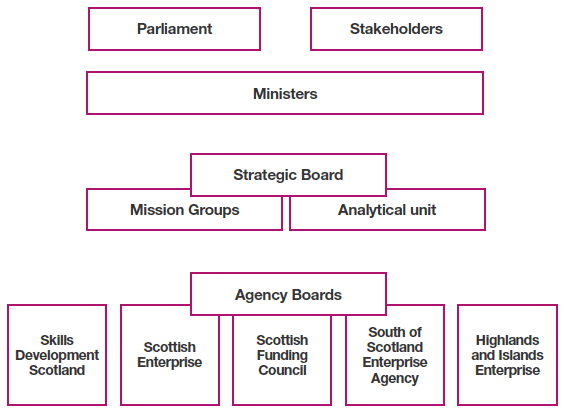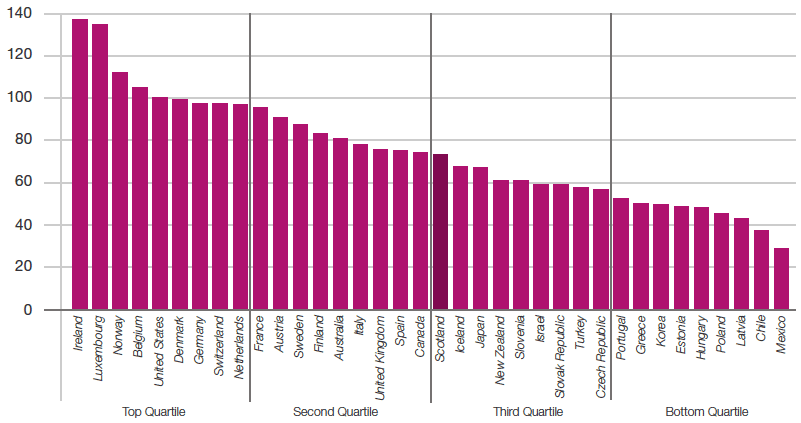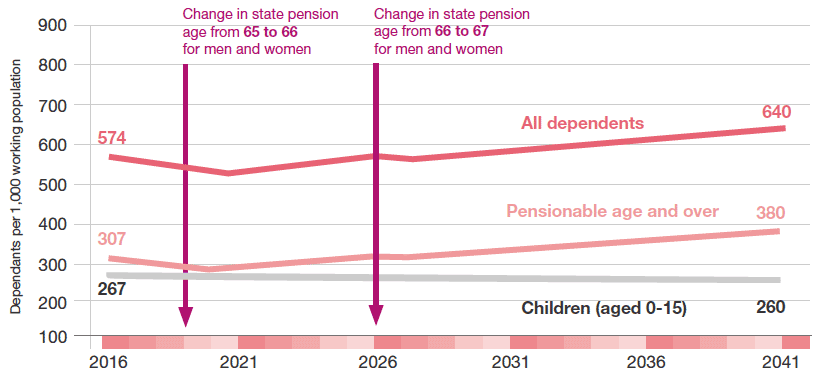Enterprise and Skills Board: strategic plan
This full plan provides clarity around strategic direction to enterprise and skills agencies and a blueprint to Government to turn up the dial on productivity and drive inclusive and sustainable economic growth.
1. Overview
Background
The Enterprise & Skills Strategic Board aligns the work of Scotland's Enterprise and Skills Agencies - Scottish Enterprise, Highlands and Islands Enterprise, Skills Development Scotland and the Scottish Funding Council, as well as the new South of Scotland Economic Partnership - behind a common purpose to drive inclusive and sustainable growth. The Board is comprised of individuals from business, trade unions, education providers, including universities and colleges, the enterprise and skills agencies and local government.

Each year, £2.4bn is invested by the Scottish Government in Scotland's enterprise and skills support. That investment, coupled with our ability in Scotland to convene the key players in one place, provides us with a genuine opportunity to make a difference. Our aim now is to realise that opportunity.
This plan gives clarity around strategic direction to the enterprise and skills agencies so that they can help Scotland move towards the top of the OECD rankings for productivity and for equality, wellbeing and sustainability.
It draws from the five key principles of the Strategic Board, to:
1. improve the overall performance of the economy by ensuring that the whole Enterprise and Skills System delivers Scotland's Economic Strategy and supporting strategies, in all parts of Scotland
2. through collective responsibility, ensure hard alignment between agencies to drive improvement in Scottish productivity and better support business and users of the skills system
3. hold agencies to account for performance against agreed measures
4. actively engage with other agencies and bodies who support the economy with a view to increasing alignment and challenging others where collaboration is not happening
5. deliver wider collective leadership, based on common culture and values, and which inspires and empowers delivery
The prize
By many measures Scotland is economically successful. We have one of the best educated populations in the world, a high employment rate and our universities' research performance is world class.
However, our productivity performance - which is a measure of how efficiently we produce goods and services - lags many other countries.
For some time, Scotland's yardstick has been countries whose productivity levels put them in the top quartile of countries belonging to the Organisation for Economic Cooperation and Development (OECD). Among the 36 OECD members, Scotland currently sits in mid-table and has done for a long time[3]. This impacts everybody - productivity is a key determinant of international competitiveness, company growth, living standards and wages.
In the most productive countries, average annual wages are over £5,000 higher than in Scotland.
Closing this gap would mean more for individuals to spend, improved business competitiveness and profits, and higher tax revenues to support better public services. It is a prize worth winning.
Scotland is currently ranked 19th out of the OECD countries when measured by GDP per hour worked[4].

Sources: "2016 Productivity levels from OECD Statistics Portal - data extracted on 07 February 2018; Output per hour worked from Scottish Labour Productivity 1998-2017 Quarter 3 - 14 February 2018".
Scotland's Economic Strategy describes how we can bridge the productivity gap through investing, innovating, internationalising. It also demonstrates how there is a growing consensus that tackling inequality - and increasing the number of people who can contribute towards economic prosperity - can boost competitiveness and growth. At present, the UK as a whole is ranked 30th out of 35 among OECD countries for income inequality[5] and Scotland's performance is likely to be similar. That is why this Strategic Plan adopts a focus on inclusive growth and builds short- and long-term actions around those foundations.
The outcomes of long-term growth have not consistently been shared:
In-work poverty is increasing: over half of working age adults in poverty now live in households with at least one adult in employment
Those sectors of our economy which employ the largest numbers such as retail, care and leisure are some of those with the lowest output per worker
One in seven people in Scotland still live in poverty
There is still a gender pay gap: Women earn 93p for every £1 a Man earns
Place is important: people from our most deprived areas live on average 10 years less than those in our least deprived areas[6]
Demography
There will be around a quarter of a million more Scots in 25 years. But there will be far fewer people of traditional working age and a drop in the numbers who would typically be in school, apprenticeship, college and university. Most marked will be the rise of more than 400,000 aged 65 and over with an extra 220,000 or so of us living beyond 80 years. This demographic shift is also projected to result in a significant increase in the dependency ratio (the ratio of those ages typically not working to those typically in the labour force), which is predicted to be felt most keenly in our rural regions[7].
Projected dependence ratios (per 1,000 working population), 2016-2041

Source: National Records of Scotland
Profound demographic change will alter the character of the country and the nature of the economy. Scots will demand and produce different types of goods and services, affecting in turn the demand for and supply of workers - for example, there will likely be many more jobs caring for the oldest in society. Employers will have to manage a dip in the supply of young people and a bulge of people in their forties.
Brexit
The UK plans to leave the European Union (EU) in 2019 but, at time of publication, the terms on which it leaves and the nature of its future relationship with the EU and other countries have not been agreed. Nor is it clear when these matters will be settled. What is apparent is that in at least two areas of direct interest to the Board, trade rules and immigration, change will be significant over the coming years.
For decades, a substantial proportion of Scotland's overseas trade has taken place under rules agreed across the EU and between the EU and other countries. The UK intends to negotiate new arrangements. Time will tell how they affect Scotland but the consensus at present is that trade will be harder to do in the foreseeable future than today.
There are some 128,000 people from other parts of the EU who work in Scotland[8] and 22,000 who study at colleges and universities[9]. New rules might make it harder for people who are here to remain and for others to come. It appears that the decision to leave the EU has already reduced the number of people from other EU states coming to work in the UK[10].
Shifting geopolitics
In the decades after World War II, western nations built diplomatic, cultural, military and economic alliances, one consequence of which was a marked rise in flows of trade, people and capital between countries, which together helped raise incomes. The depth and pace of globalisation increased rapidly from the 1980s as emerging nations such as China opened up to the world.
Recently, the pace of globalisation has slowed and some of the pillars of the post-1945 settlement and prosperity look shakier with a slowdown in capital flows and signs such as increases in trade tariffs point to protectionism becoming more popular.
In parallel, we see shifts in economic power. While the 'BRICS' countries - Brazil, Russia, India, China and South Africa - have attracted much attention, other emerging markets such as Indonesia and Asian, South American and African nations have the potential to be key drivers of future global growth[11].
Technological change
Some call it "Industry 4.0" others "The Second Machine Age". The defining characteristics of this new wave of innovation today are that it is exponential, digital and makes combining innovations from different sources easy[12]. Already, these have provided useful artificial intelligence and connected most people on the planet through the internet. It is impossible to predict the future with any precision but many technologists and economists forecast that the speed and scale of technological change will continue to increase.
Like past innovations those changes will boost incomes - but they will also cause disruption (e.g. to existing business models and the structure of industry) and could also widen income inequalities. Opportunities to create and expand new businesses to meet undreamt of needs or simply to do better the things done today will leave Scotland wealthier. However, this will not happen simply due to innovation and technology that we import from elsewhere - we need to ensure that Scottish businesses are the producers or pioneers of that innovation, and we need to support those in the workforce who are displaced by technological change to adapt, upskill and reskill to the future economy.
Climate Change
Climate change is probably the most significant event of our times. It is increasingly clear that the planet cannot sustain current models of production and consumption.
The recent UN Intergovernmental Panel on Climate Change (IPCC) report[13] suggested that limiting global warming to 1.5°C would require "rapid and far-reaching" transitions in land, energy, industry, buildings, transport, and cities. Further, with clear benefits to people and natural ecosystems, limiting global warming to 1.5°C could go hand in hand with ensuring a more sustainable and equitable society.
In many regards, Scotland is already a world-leader in this aspect, with existing aspirations to become carbon-neutral by 2050. The transition to a carbon-neutral economy will open opportunities for innovative solutions - both in terms of mitigation and adaptation - that would tap into a global demand.
What is different about this plan?
The goal is the top quartile of OECD countries. To achieve this means out-competing other countries and, recognising this, this plan that has two overarching features:
- a clear sense of what matters most, what will make the biggest difference and where priorities should lie; and
- agility to adjust course as the world changes, and to respond quickly to new opportunities as they arise.
Inclusive growth has been a guiding principle in developing this plan with a focus on place, participation and sharing value. Fair work - combining growth with increased prosperity, greater equality and creating opportunities for all - is integral to all parts of the plan.
While this plan recognises the imperative for action now, it also accepts the long-term nature of the ambition. We must be in this for the long-haul, setting our sights on a twenty-year time horizon, with sustained and unrelenting commitment to the actions and prioritisation required.
This plan is a vision for improving the enterprise and skills system as a whole. It transcends the boundaries between the agencies and so enables genuine collaborative effort to be rallied behind strategic purpose. This collaboration, in combination with better use of data and clarity around national, regional and local conditions, will be critical to its success.
The plan also proposes strategic changes which have implications for the wider enterprise and skills system, and therefore seeks to influence other key players, including both central and local government, education and training providers and, most especially, the business community.
How the plan fits together
This plan gives strategic direction to the delivery agencies and additional advice to Scottish Ministers. It builds on the key themes and early successes of the Enterprise & Skills Review.
Over the summer, the Board has pursued four initial 'missions' - deep consideration of the factors contributing to productivity growth. Section 2 of this plan describes these missions in more detail, and highlights a series of actions and recommendations for improvement. Section 3 shows how collaboration and alignment across each of the agencies - and beyond - is already making a difference in how we provide support to customers. Progress against our aims will be monitored through the Board's performance framework, which is set out in Section 4. Finally, Section 5 sets out the next steps for the Board.
Contact
There is a problem
Thanks for your feedback